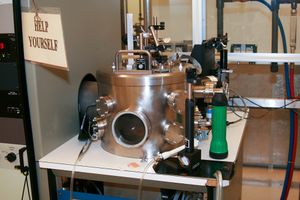RIE 2 (MRC)
| |||||||||||||||||||||
About
This is a Materials Research Corporation RIE-51 parallel plate, 13.56 Mhz system used primarily for the etching of InP with CH4/H2/Ar gases, although it can be used to etch As- and Sb-based III-V compounds and a variety of II-VI semiconductors as well. For Al-containing compounds and II-VI compounds, high bias power is required. Tool features include: six inch diameter water cooled cathode/substrate platform, pyrex cylinder for plasma confinement and gas flow control, adjustable cathode-anode spacing, fixed bias or power control and HeNe laser etch monitor with chart recorder. It is diffusion pumped and has no loadlock. Various etching applications have included: in-plane lasers/facets, InP-based HBTs, FET gate recessing, InP-based quantum microcavities, Bragg-Fresnel x-ray lenses and waveguides.
RIE of InP and related compounds can be achieved with a hydride-based process chemistry of methane/hydrogen with an etching mechanism due to a "reverse" metalorganic CVD reaction. Because both etching and deposition occur simultaneously, it is important to use the proper gas flows and to periodically remove any polymer reaction by-products deposited on the non-etched (mask) surfaces. (This system has an additional flow circuit in order to bleed in small amounts, <1 sccm, of O2). Alternatively, one can perform cyclic etching between MHA and O2 to keep polymer formation to a minimum. With this technique selectivity is quite high and anisotropic etching can be achieved. While a metal, dielectric or photoresist may be used as a mask, photoresist should only be used at low bias voltages in order to avoid mask pattern distortions due to reflow. A precoat etch should be done before etching to condition the chamber.
Detailed Specifications
- Etch gases include: CH4, H2, Ar and O2
- Low 1 E -6 ultimate chamber pressure
- 13.56 Mhz excitation frequency
- Sample size limited to approximately 2 inches
- HeNe and IR laser monitoring for endpoint
- Automatic tuning network
- DC Bias or RF power control
- Masking materials include: Ni, SiON, photoresist (limited to low bias/power)
- Typical etch conditions for InGaAsP:
- 75 mT (CH4/H2/Ar : 4/20/10 sccm)
- 450v bias
- ~ 45 nm/min. etch rate
